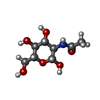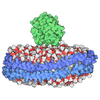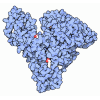[English] 日本語
 Yorodumi
Yorodumi- EMDB-49761: Identification and non-clinical characterization of SAR444200, a ... -
+ Open data
Open data
- Basic information
Basic information
| Entry |  | |||||||||
|---|---|---|---|---|---|---|---|---|---|---|
| Title | Identification and non-clinical characterization of SAR444200, a novel anti-GPC3 T-cell engager, for the treatment of GPC3+ solid tumors | |||||||||
 Map data Map data | ||||||||||
 Sample Sample |
| |||||||||
 Keywords Keywords | GRIPS / ONCOPROTEIN-IMMUNE SYSTEM complex | |||||||||
| Function / homology |  Function and homology information Function and homology informationpeptidyl-dipeptidase inhibitor activity / mesonephric duct morphogenesis / regulation of protein localization to membrane / body morphogenesis / cell proliferation involved in kidney development / regulation of non-canonical Wnt signaling pathway / mesenchymal cell proliferation involved in ureteric bud development / Defective B3GALT6 causes EDSP2 and SEMDJL1 / Defective B4GALT7 causes EDS, progeroid type / Defective B3GAT3 causes JDSSDHD ...peptidyl-dipeptidase inhibitor activity / mesonephric duct morphogenesis / regulation of protein localization to membrane / body morphogenesis / cell proliferation involved in kidney development / regulation of non-canonical Wnt signaling pathway / mesenchymal cell proliferation involved in ureteric bud development / Defective B3GALT6 causes EDSP2 and SEMDJL1 / Defective B4GALT7 causes EDS, progeroid type / Defective B3GAT3 causes JDSSDHD / Defective EXT2 causes exostoses 2 / Defective EXT1 causes exostoses 1, TRPS2 and CHDS / cell proliferation involved in metanephros development / Glycosaminoglycan-protein linkage region biosynthesis / HS-GAG biosynthesis / cell migration involved in gastrulation / HS-GAG degradation / negative regulation of growth / positive regulation of Wnt signaling pathway, planar cell polarity pathway / positive regulation of BMP signaling pathway / coronary vasculature development / positive regulation of smoothened signaling pathway / embryonic hindlimb morphogenesis / anterior/posterior axis specification / regulation of canonical Wnt signaling pathway / Wnt signaling pathway, planar cell polarity pathway / branching involved in ureteric bud morphogenesis / smoothened signaling pathway / RSV-host interactions / bone mineralization / Respiratory syncytial virus (RSV) attachment and entry / positive regulation of endocytosis / anatomical structure morphogenesis / canonical Wnt signaling pathway / Retinoid metabolism and transport / side of membrane / lysosomal lumen / lung development / osteoclast differentiation / epithelial cell proliferation / positive regulation of D-glucose import across plasma membrane / negative regulation of smoothened signaling pathway / Post-translational protein phosphorylation / response to bacterium / negative regulation of canonical Wnt signaling pathway / Golgi lumen / Regulation of Insulin-like Growth Factor (IGF) transport and uptake by Insulin-like Growth Factor Binding Proteins (IGFBPs) / negative regulation of epithelial cell proliferation / positive regulation of protein catabolic process / positive regulation of canonical Wnt signaling pathway / cell migration / Attachment and Entry / endoplasmic reticulum lumen / cell surface / plasma membrane Similarity search - Function | |||||||||
| Biological species |  Homo sapiens (human) / Homo sapiens (human) /  | |||||||||
| Method | single particle reconstruction / cryo EM / Resolution: 4.04 Å | |||||||||
 Authors Authors | Batchelor JD / Svidritskiy E | |||||||||
| Funding support | 1 items
| |||||||||
 Citation Citation |  Journal: Mol Cancer Ther / Year: 2025 Journal: Mol Cancer Ther / Year: 2025Title: Identification and non-clinical characterization of SAR444200, a novel anti-GPC3 NANOBODY® T-cell engager, for the treatment of GPC3+ solid tumors. Authors: Paolo Meoni / Ana Paula B Vintém / Virna F Cortez-Retamozo / Jasper Jacobs / Evelyn De Tavernier / Paola Fiorentini / Diane Van Hoorick / Joseph D Batchelor / Egor Svidritskiy / Yu Qiu / ...Authors: Paolo Meoni / Ana Paula B Vintém / Virna F Cortez-Retamozo / Jasper Jacobs / Evelyn De Tavernier / Paola Fiorentini / Diane Van Hoorick / Joseph D Batchelor / Egor Svidritskiy / Yu Qiu / Eline Dejonckheere / Aiqun Li / Lily I Pao / Marie-Ange Buyse /    Abstract: T-cell engager (TCE) immunotherapy has demonstrated significant clinical activity in multiple cancers by inducing co-engagement of T-cells and tumor cells, resulting in T-cell activation and T-cell- ...T-cell engager (TCE) immunotherapy has demonstrated significant clinical activity in multiple cancers by inducing co-engagement of T-cells and tumor cells, resulting in T-cell activation and T-cell-dependent cellular cytotoxicity (TDCC) against tumor cells. Current-generation TCEs are predominantly composed of antibody-based binding domains targeting the CD3e molecule of the T-cell antigen receptor (TCR)/CD3 complex on T-cells and a tumor-associated antigen on tumor cells. However, limitations of this approach include cytokine release syndrome and a limited therapeutic window. Here, we report the generation and preclinical evaluation of SAR444200, the first NANOBODY®-based TCE clinical candidate binding to TCRαβ and GPC3 to co-engage T-cells and GPC3+ tumor cells, causing TDCC. SAR444200 bound with nanomolar to picomolar affinity to TCRαβ and GPC3 respectively and induced in vitro TDCC against multiple human tumor cell lines with differential GPC3 expression with picomolar potency. In vivo analysis using human cancer cell line-derived (HuH-7 and HepG2) xenografts in immunodeficient mice showed complete tumor regression at doses starting from 0.7 mg/kg. In exploratory non-human primate studies, intravenous administration of SAR444200 was well tolerated up to 8 mg/kg and exhibited greater than dose-proportional clearances and dose-proportional maximum concentrations across the tested dose range. The highly potent and efficacious activity of SAR444200 in diverse models of GPC3+ tumors and the extremely wide tolerated dose range merits further development of this compound. Furthermore, NANOBODY®-based TCEs developed using an anti-TCRαβ moiety may have specific advantages for the development of TCEs. | |||||||||
| History |
|
- Structure visualization
Structure visualization
| Supplemental images |
|---|
- Downloads & links
Downloads & links
-EMDB archive
| Map data |  emd_49761.map.gz emd_49761.map.gz | 229.9 MB |  EMDB map data format EMDB map data format | |
|---|---|---|---|---|
| Header (meta data) |  emd-49761-v30.xml emd-49761-v30.xml emd-49761.xml emd-49761.xml | 16 KB 16 KB | Display Display |  EMDB header EMDB header |
| Images |  emd_49761.png emd_49761.png | 57.1 KB | ||
| Filedesc metadata |  emd-49761.cif.gz emd-49761.cif.gz | 6 KB | ||
| Others |  emd_49761_half_map_1.map.gz emd_49761_half_map_1.map.gz emd_49761_half_map_2.map.gz emd_49761_half_map_2.map.gz | 226.3 MB 226.3 MB | ||
| Archive directory |  http://ftp.pdbj.org/pub/emdb/structures/EMD-49761 http://ftp.pdbj.org/pub/emdb/structures/EMD-49761 ftp://ftp.pdbj.org/pub/emdb/structures/EMD-49761 ftp://ftp.pdbj.org/pub/emdb/structures/EMD-49761 | HTTPS FTP |
-Validation report
| Summary document |  emd_49761_validation.pdf.gz emd_49761_validation.pdf.gz | 760.2 KB | Display |  EMDB validaton report EMDB validaton report |
|---|---|---|---|---|
| Full document |  emd_49761_full_validation.pdf.gz emd_49761_full_validation.pdf.gz | 759.8 KB | Display | |
| Data in XML |  emd_49761_validation.xml.gz emd_49761_validation.xml.gz | 16 KB | Display | |
| Data in CIF |  emd_49761_validation.cif.gz emd_49761_validation.cif.gz | 19.1 KB | Display | |
| Arichive directory |  https://ftp.pdbj.org/pub/emdb/validation_reports/EMD-49761 https://ftp.pdbj.org/pub/emdb/validation_reports/EMD-49761 ftp://ftp.pdbj.org/pub/emdb/validation_reports/EMD-49761 ftp://ftp.pdbj.org/pub/emdb/validation_reports/EMD-49761 | HTTPS FTP |
-Related structure data
| Related structure data |  9ntqMC  9bdoC  9nrjC M: atomic model generated by this map C: citing same article ( |
|---|---|
| Similar structure data | Similarity search - Function & homology  F&H Search F&H Search |
- Links
Links
| EMDB pages |  EMDB (EBI/PDBe) / EMDB (EBI/PDBe) /  EMDataResource EMDataResource |
|---|---|
| Related items in Molecule of the Month |
- Map
Map
| File |  Download / File: emd_49761.map.gz / Format: CCP4 / Size: 244.1 MB / Type: IMAGE STORED AS FLOATING POINT NUMBER (4 BYTES) Download / File: emd_49761.map.gz / Format: CCP4 / Size: 244.1 MB / Type: IMAGE STORED AS FLOATING POINT NUMBER (4 BYTES) | ||||||||||||||||||||||||||||||||||||
|---|---|---|---|---|---|---|---|---|---|---|---|---|---|---|---|---|---|---|---|---|---|---|---|---|---|---|---|---|---|---|---|---|---|---|---|---|---|
| Projections & slices | Image control
Images are generated by Spider. | ||||||||||||||||||||||||||||||||||||
| Voxel size | X=Y=Z: 0.885 Å | ||||||||||||||||||||||||||||||||||||
| Density |
| ||||||||||||||||||||||||||||||||||||
| Symmetry | Space group: 1 | ||||||||||||||||||||||||||||||||||||
| Details | EMDB XML:
|
-Supplemental data
-Half map: #1
| File | emd_49761_half_map_1.map | ||||||||||||
|---|---|---|---|---|---|---|---|---|---|---|---|---|---|
| Projections & Slices |
| ||||||||||||
| Density Histograms |
-Half map: #2
| File | emd_49761_half_map_2.map | ||||||||||||
|---|---|---|---|---|---|---|---|---|---|---|---|---|---|
| Projections & Slices |
| ||||||||||||
| Density Histograms |
- Sample components
Sample components
-Entire : GPC3_A0026015A08 complex
| Entire | Name: GPC3_A0026015A08 complex |
|---|---|
| Components |
|
-Supramolecule #1: GPC3_A0026015A08 complex
| Supramolecule | Name: GPC3_A0026015A08 complex / type: complex / ID: 1 / Parent: 0 / Macromolecule list: #1-#2 |
|---|---|
| Source (natural) | Organism:  Homo sapiens (human) Homo sapiens (human) |
-Macromolecule #1: Glypican-3
| Macromolecule | Name: Glypican-3 / type: protein_or_peptide / ID: 1 / Number of copies: 1 / Enantiomer: LEVO |
|---|---|
| Source (natural) | Organism:  Homo sapiens (human) Homo sapiens (human) |
| Molecular weight | Theoretical: 50.961965 KDa |
| Recombinant expression | Organism:  Homo sapiens (human) Homo sapiens (human) |
| Sequence | String: CHQVRSFFQR LQPGLKWVPE TPVPGSDLQV CLPKGPTCCS RKMEEKYQLT ARLNMEQLLQ SASMELKFLI IQNAAVFQEA FEIVVRHAK NYTNAMFKNN YPSLTPQAFE FVGEFFTDVS LYILGSDINV DDMVNELFDS LFPVIYTQLM NPGLPDSALD I NECLRGAR ...String: CHQVRSFFQR LQPGLKWVPE TPVPGSDLQV CLPKGPTCCS RKMEEKYQLT ARLNMEQLLQ SASMELKFLI IQNAAVFQEA FEIVVRHAK NYTNAMFKNN YPSLTPQAFE FVGEFFTDVS LYILGSDINV DDMVNELFDS LFPVIYTQLM NPGLPDSALD I NECLRGAR RDLKVFGNFP KLIMTQVSKS LQVTRIFLQA LNLGIEVINT TDHLKFSKDC GRMLTRMWYC SYCQGLMMVK PC GGYCNVV MQGCMAGVVE IDKYWREYIL SLEELVNGMY RIYDMENVLL GLFSTIHDSI QYVQKNAGKL TTTIGKLCAH SQQ RQYRSA YYPEDLFIDK KVLKVAHVEH EETLSSRRRE LIQKLKSFIS FYSALPGYIC SHSPVAENDT LCWNGQELVE RYSQ KAARN GMKNQFNLHE LKMKGPEPVV SQIIDKLKHI NQLLRTMS UniProtKB: Glypican-3 |
-Macromolecule #2: A0226015A08
| Macromolecule | Name: A0226015A08 / type: protein_or_peptide / ID: 2 / Number of copies: 1 / Enantiomer: LEVO |
|---|---|
| Source (natural) | Organism:  |
| Molecular weight | Theoretical: 12.610134 KDa |
| Recombinant expression | Organism:  |
| Sequence | String: DVQLVESGGG LVQPGGSLRL SCVASGS(UNK)FR SVFSSSTMEW YRQPPGKKRE LVARIAPGDG TNYGALYADS VKGRFT ISR DDAKKTVDLQ MNSLKPEDTG VYFCASGVAW GQGTLVTVSS |
-Macromolecule #3: 2-acetamido-2-deoxy-beta-D-glucopyranose
| Macromolecule | Name: 2-acetamido-2-deoxy-beta-D-glucopyranose / type: ligand / ID: 3 / Number of copies: 1 / Formula: NAG |
|---|---|
| Molecular weight | Theoretical: 221.208 Da |
| Chemical component information |  ChemComp-NAG: |
-Experimental details
-Structure determination
| Method | cryo EM |
|---|---|
 Processing Processing | single particle reconstruction |
| Aggregation state | 2D array |
- Sample preparation
Sample preparation
| Buffer | pH: 7.4 |
|---|---|
| Vitrification | Cryogen name: ETHANE |
- Electron microscopy
Electron microscopy
| Microscope | TFS KRIOS |
|---|---|
| Image recording | Film or detector model: GATAN K2 IS (4k x 4k) / Average electron dose: 80.0 e/Å2 |
| Electron beam | Acceleration voltage: 300 kV / Electron source:  FIELD EMISSION GUN FIELD EMISSION GUN |
| Electron optics | Illumination mode: FLOOD BEAM / Imaging mode: BRIGHT FIELD / Nominal defocus max: 2.5 µm / Nominal defocus min: 1.2 µm |
| Experimental equipment |  Model: Titan Krios / Image courtesy: FEI Company |
 Movie
Movie Controller
Controller








 Z (Sec.)
Z (Sec.) Y (Row.)
Y (Row.) X (Col.)
X (Col.)




































